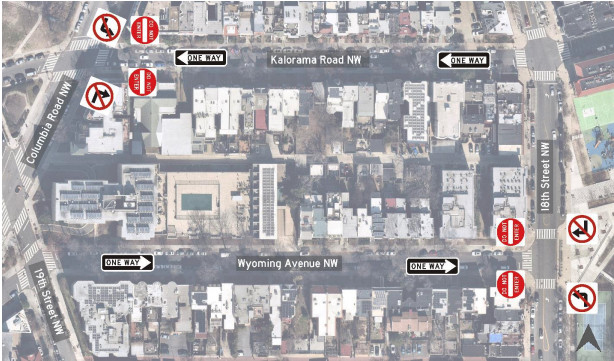Sections of Wyoming Avenue and Kalorama Road NW to become one-way streets

18th Street and Kalorama Rd. NW intersection in DC by the author.
The Adams Morgan streetscape is changing in order to reduce congestion in the area - as the District Department of Transportation (DDOT) implements plans to convert parts of Kalorama Road NW and Wyoming Avenue NW into one-way thoroughfares.
Kalorama Road from 18th Street to Columbia Road NW will be converted into a one-way westbound lane. Wyoming Avenue between 18th and 19th street will be converted into a one-way eastbound lane, according to a document from DDOT.
Dedicated contra-flow bike lanes and speedbumps will also be added, the document added, allowing bike traffic to use the streets going both directions.
“Once the design is finalized, we will create a website with detailed information and a comment period,” a DDOT spokesperson said, adding that roadwork will likely begin during the “construction season of 2023.”
Diagram of street changes from DDOT planning materials Image by DDOT.
Greater Greater Washington previously reported that Adams Morgan’s Advisory Neighborhood Commissioner Peter Wood is a prominent supporter of the project and worked to prioritize the task. “Previous commissioners had spent years trying to get this project to happen,” Wood said in a Tweet.
Some community members have concerns about the project, however.
Chip Cannon lives on Kalorama Road with his three young children and has been a resident of Adams Morgan for over 25 years.
“There always seems to be congestion on our block,” Cannon said, noting that traffic slows things down - in a healthy way, “I worry about making it one way because cars are just going to go faster.”
His concern is that party culture on 18th Street will encourage speeding up the block, endangering neighborhood kids. “I don’t see the real benefit,” he said regarding street changes.
Concern around the safety of one-way streets has become a national debate over the last few years. A 2017 op-ed by transportation engineer Mike Brown explored the pros and cons of one-way streets along with factors that can mitigate safety risks. Virtual cues such as flashing radar signs, re-striping of designated lanes, and lower suggested speed limits can make a difference, a Milwaukee case study found.
Speedbumps play a significant role in the success of the changes in terms of community safety, Wood said. “While lane configuration is only a small piece in making city transportation safer and more sustainable, I share excitement with Adams Morgan constituents who are ready to stop seeing drivers blast their horns, scream at each other, and swipe into cars because the streets are too narrow for two-way traffic.”
Despite community concerns, the Adams Morgan Circulation Study found that conversion of the streetscape wouldn’t negatively impact the traffic in the neighborhood, according to DDOT documentation.
Though the project is still in the early stages of ideation and development, DDOT confirmed the long-awaited project on September 27. Community members and stakeholders have until November 9 to comment before plans are solidified.
“Will this change resolve congestion? Maybe only partially, but even partial progress moves us forward,” Wood said.
